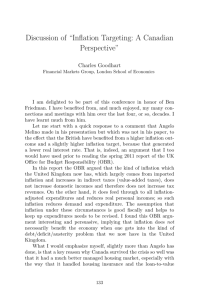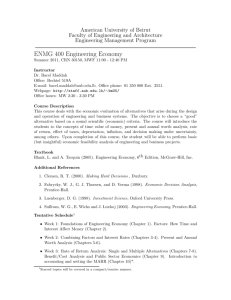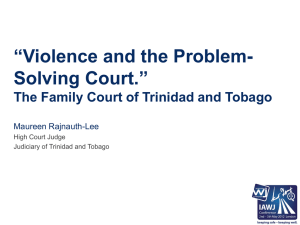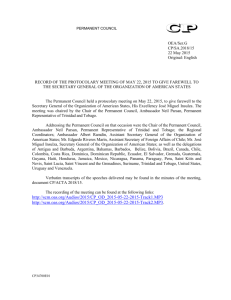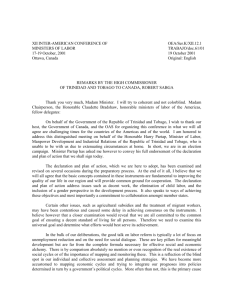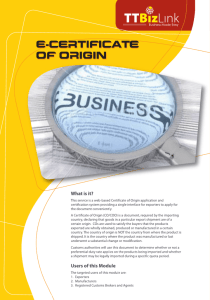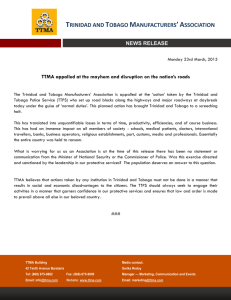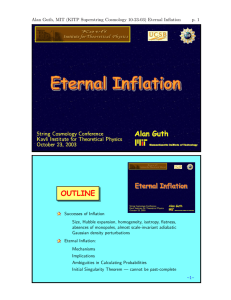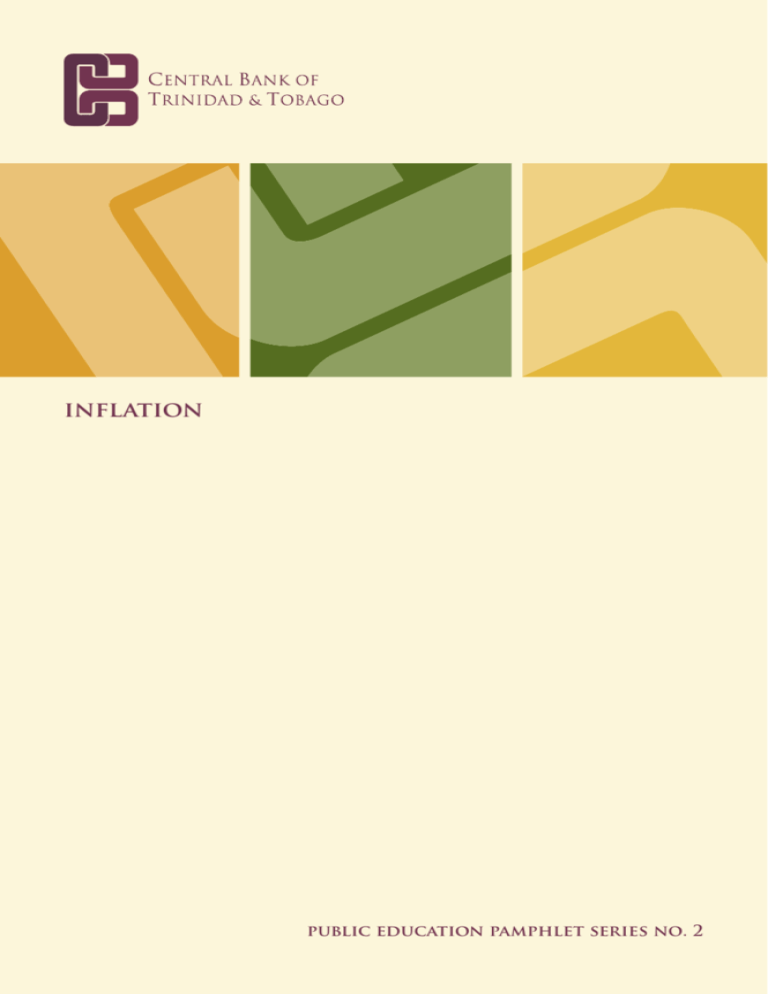
inflation
public education pamphlet series no. 2
public education pamphlet series
ISSN: 1817-1360.
editorial board
EWART S. WILLIAMS
Governor,
Central Bank of Trinidad and Tobago
SHELTON NICHOLLS
Deputy Governor, Research and Policy,
Central Bank of Trinidad and Tobago
JOAN JOHN
Deputy Governor, Operations,
Central Bank of Trinidad and Tobago
OSBORNE NURSE
Chairman, Trinidad and Tobago
Securities and Exchange Commission
MARY KING
Chairman,
Mary King and Associates
RONALD RAMKISSOON
Senior Economist,
Republic Bank Limited
DIONNE GRAY
Corporate Communications Officer,
Central Bank of Trinidad and Tobago
All rights reserved.
No part of this publication may be reproduced in any form or otherwise without
the permission in writing of the Central Bank of Trinidad and Tobago.
ISBN: 978-976-95154-5-0.
© Central Bank of Trinidad and Tobago, July 2006.
FOREWORD
External communications are an important part of the business
of the Central Bank of Trinidad and Tobago. The Bank’s outreach
initiatives are intended both to enhance its contribution to educating
and informing the public generally, as well as to assist markets in
understanding the Bank’s policy actions and intentions.
In addition to the regular publications of its Research Department,
the Bank’s Outreach Programme has included lectures and
speeches to school children by senior Bank officials, mentoring to
undergraduate students and supporting an internship arrangement
with the University of the West Indies.
This public education series is also a part of the Programme. Its
intention is to provide information on topics and policies that are
relevant to the management of the economy of Trinidad and Tobago.
The world of business and trade is a fast-paced, ever-changing and
challenging one, and the tools of knowledge and information must be
strategically used to navigate it.
This pamphlet series is geared towards a broad readership. It is
likely to be a good source of information for students at the secondary
and tertiary levels, professionals and other members of the public
who are interested in increasing their knowledge of economics and
business.
The pamphlet will be published on a quarterly basis and will cover
current and topical issues and explain new economic initiatives. In
the series, every effort will be made to present the material in as nontechnical a manner as possible while adhering to sound economic
analysis and the highest editorial standards.
To this end, the Bank has invited three well-known economists
from the private sector to join the editorial team, firstly to suggest
inflation
FOREWORD
topics that would be of interest to the public and secondly, to advise
on ways to reach the target audience. The Bank also intends to
invite guest contributors to the series from time to time.
We hope that the series raises the level of public awareness
and public discourse on economic issues, and contributes to the
strengthening of economic policy formation in Trinidad and Tobago.
Ewart S. Williams
Governor
inflation
Inflation
A. Definitions
Inflation is a sustained increase in the general level of prices.
Since inflation is concerned with increases in the general level of
prices, changes in the price of a single good or service cannot be
characterized as inflation. The inflation rate is normally measured
by percentage changes in the cost of a basket of consumer goods
and services. In Trinidad and Tobago, the Retail Prices Index is the
indicator used to measure inflation.
Inflation, as measured by the change in the overall retail prices
index, is sometimes called “headline” inflation. This contrasts with
core inflation, which excludes volatile changes in the prices of items
like food (and in some countries, fuel).
The inflation rate for the year is measured either by the increase
in the average value of the index over the previous year or the
December-to-December increase in the index. By convention, the
point-to-point increase is more widely used.
The term “hyper-inflation” has been coined to describe a scenario
whereby prices rise to very high double-digit rates (usually in excess
of 50 per cent). Hyper-inflation seriously erodes purchasing power,
completely distorts economic signals and leaves the currency virtually
worthless.
While mild inflation (of 2–3 per cent) is not considered a problem
and may even provide useful support for resource allocation, it is widely
accepted that inflation beyond single digits is highly distortionary. As
a general rule, countries try to keep the domestic rate of inflation
close to that of their trading partners to preserve competitiveness.
In Trinidad and Tobago, the Government aims at maintaining an
inflation rate of 4–5 per cent (measured on a December to December
basis).
1
inflation
B. Sources of Inflation
Inflation can be explained by “demand-pull” and/or “cost-push”
factors. Demand-pull inflation relates to the adage “too much
money chasing too few goods”. It is normally associated with money
creation which, in most cases, comes from the monetization of a
fiscal deficit, i.e. the provision of central bank credit to government
to finance a fiscal deficit. In Trinidad and Tobago, while the fiscal
accounts are in overall surplus, the drawdown of deposits at the
Central Bank (the counterpart of energy sector revenues) to finance
the non-energy fiscal deficit has a similar effect as money creation.
Since the wage bill is normally a sizable part of production costs,
cost-push inflation could also result from an increase in wage rates
in excess of productivity gains. Cost-push inflation may also be the
result of increases in the prices of key inputs such as electricity,
gasoline and transportation which affect the cost of a wide range
of goods and services. Cost-push inflation could result from the
devaluation of the currency which increases the prices of imported
inputs in domestic currency terms.
C. Consequences of Inflation
Inflation can have widespread negative effects on various sectors
of the economy, and high inflation prompts those affected to seek to
protect the real value of their incomes. This makes the maintenance
of relative price stability a paramount objective of economic policy.
First, inflation affects the purchasing power of money, i.e. it
reduces the quantity of goods that can be purchased with a given
amount of money. The higher the inflation rate, the faster one’s
purchasing power is eroded. Thus, for example, if inflation averaged
2
inflation
7 per cent a year for three consecutive years, then over the period,
individuals would have effectively lost $196 out of every $1,000 held
in cash.
Second, inflation distorts incentives to save. Under inflationary
conditions, one’s purchasing power is eroded over time and this
encourages consumption rather than savings. For this reason, high
inflation puts upward pressure on interest rates as savers demand
compensation to forego consumption.
Inflation also affects investment decisions as it adds greater
uncertainty to the future and this complicates business planning.
Economic agents seek to protect themselves from the
consequences of inflation in several ways. For example, savers
seek to protect themselves by demanding higher interest rates. They
also avoid making long-term commitments and tend to prefer to hold
short-term assets. More generally, in an inflationary environment,
savers tend to avoid fixed-income investments in favor of assets
where returns may adjust in line with inflation, such as indexed
bonds or equities. On the lending side, in inflationary conditions,
lenders tend to eschew fixed interest rate for variable interest rate
loans (including mortgages).
Wage earners protect themselves by seeking larger wage
settlements. In fact, especially when inflation is on the rise, trade
unions tend to insist that wage agreements contain cost of living
clauses as a means of protecting workers against inflation. Ironically,
wage indexation has an inherent inflationary bias and can easily
lead to a wage-price spiral – a situation in which one round of wage
increases results in subsequent rounds of price increases which
prompt further wage increases.
3
inflation
High inflation, or even moderate inflation sustained for a prolonged
period, could foster an inflation psychology or inflationary
expectations1. For example, if workers believe that inflation would
remain high or is likely to be higher in the future, their wage demands
are likely to reflect these expectations. Experience in non-competitive
markets has shown that manufacturers and distributors are inclined
to increase prices in anticipation of cost increases.
While some are able to protect themselves, inflation affects
disproportionately those who are on fixed incomes, like
pensioners and the poor. These groups face major hardships also
because a significant part of their income is spent on basic cost-ofliving items which are most affected by inflation.
D. The Inflation Experience of Trinidad and Tobago
During the last three decades, Trinidad and Tobago has had mixed
experiences with inflation. Over the period, inflation has tended to
follow a pro-cyclical path, rising in times of economic boom and falling
during recessionary periods (Figure 1).
Figure 1
Trinidad and Tobago Inflation Profile, 1972 - 2005
25.0
Oil price spike
Per Cent
20.0
T T $Devaluation
15.0
VAT
T T $ Floatation
10.0
5.0
B oom
R eces s ion
R ecovery & Growth
19
72
19
74
19
76
19
78
19
80
19
82
19
84
19
86
19
88
19
90
19
92
19
94
19
96
19
98
20
00
20
02
20
04
20
05
-
Source: Central Bank of Trinidad and Tobago.
1
Inflationary expectations must be distinguished from inflationary perceptions. The latter refers to the belief by consumers that the
rate of increase in prices is larger than indicated by the consumer price index.
4
inflation
1973 - 1982
In the 1970s, the sharp rise in crude oil prices resulted in a
significant increase in government expenditure which boosted growth
and stimulated aggregate demand. With the non-energy fiscal deficit
increasing sharply, inflation was at double-digit levels throughout this
period. Between 1973 and 1982, the rate of inflation averaged 14.4
per cent and reached as high as 22 per cent in 1974 (Table 1).
TABLE 1
Selected economic indicators (1973 - 1982)
R eal G DP
G r owth R ate
%
Non-Energy
I nflation R ate** Fiscal Deficit
%
(% of G DP)
Y ear
Crude Oil
Prices
US$/bbl*
1973
2.70
1.7
14.8
-10.6
1974
9.76
3.8
22.0
-13.2
1975
10.72
1.5
17.0
-14.0
1976
11.51
6.4
10.4
-19.5
1977
12.40
9.1
11.8
-16.9
1978
12.70
10.2
10.2
-21.7
1979
17.26
3.6
14.7
-26.4
1980
28.67
10.4
17.5
-25.3
1981
32.50
4.6
14.3
-25.4
1982
33.47
3.8
11.4
-30.9
* Saudi Arabian Light crude was used as the marker crude for the period 1975-1988.
** period average.
Sources: Central Bank of Trinidad and Tobago and the Central Statistical Office.
1983-1992
Against the backdrop of a significant fall in government revenues
resulting from the crash in crude oil prices, the economy slipped into
a recession that lasted for about ten years (between 1983 and 1992).
During this recessionary period, inflation eased markedly as the
government implemented a number of fiscal adjustment measures
which succeeded in significantly reducing private demand and the
non-energy fiscal deficit (Table 2).
5
inflation
TABLE 2
Selected economic indicators (1983 - 1992)
R eal G DP
G r owth R ate
%
Non-Energy
I nflation R ate** Fiscal Deficit
%
(% of G DP)
Y ear
Crude Oil
Prices
US$/bbl*
1983
29.31
-10.3
16.7
-26.4
1984
28.47
-5.8
13.3
-26.8
1985
28.00
-4.1
7.7
-21.1
1986
15.00
-3.3
7.7
-17.2
1987
17.25
-4.6
10.8
-18.1
1988
13.43
-3.9
7.8
-14.6
1989
19.58
-0.8
11.4
-14.3
1990
24.12
1.5
11.0
-12.0
1991
21.62
2.7
3.8
-12.3
1992
20.57
- 1.6
6.5
-10.6
*
**
Saudi Arabian Light crude was used as the marker crude for the period 1975-1988. For the period 1989-2005,
West Texas Intermediate (WTI) was used as the marker crude.
period average.
Sources: Central Bank of Trinidad and Tobago and the Central Statistical Office.
1993-2004
Since 1993, Trinidad and Tobago has been experiencing
significantly lower inflation. This can be traced to the pursuit of more
disciplined demand management policies and the process of trade
liberalisation which has facilitated an increase in imports.
Between 1994 and 2000, annual headline inflation averaged 4.8
per cent. Headline inflation which declined to an average of 3.7 per
cent between 2003 and 2004 surged to 6.9 per cent in 2005. The
sharp increase in inflation in 2005 reflected the resurgence in the
prices of food items which accounted for 18 per cent of the basket
6
inflation
TABLE 3
Selected economic indicators (1993 - 2005)
R eal G DP
G r owth R ate
%
Non-Energy
I nflation R ate** Fiscal Deficit
%
(% of G DP )
Y ear
Crude Oil
Prices
US$/bbl*
1993
18.45
-1.5
10 . 8
-7.4
1994
17.14
3.6
8.8
-6.5
1955
18.44
3.8
5.3
-7.8
1996
22.20
3.9
3.3
-8.4
1997
20.35
2.7
3.6
-5.7
1998
14.40
7.8
5.6
-6.4
1999
19.25
4.4
3.4
-7.8
2000
30.29
7.3
3.6
-7.1
2001
26.09
4.3
5.5
-6.8
2002
26.03
6.8
4.2
-6.7
2003
31.34
13.2
3.8
-7.5
2004
41.47
6.2
3.7
-8.8
2005
56.53
7.0
6.9
-11.3
*
**
West Texas Intermediate (WTI) was used as the marker crude for the period 1989-2005.
period average.
Sources: Central Bank of Trinidad and Tobago and the Central Statistical Office.
of goods and services used for the computation of the Retail Prices
Index.
Food and Non-Food Prices
An unusually strong increase in food prices has played a major
role in the inflation performance of Trinidad and Tobago since the
mid-1990s. This increase in food prices has been significantly larger
than that experienced by our neighbouring Caribbean territories
(Table 4).
7
inflation
TABLE 4
Movement of Food Prices In The Caribbean
/End of Period/
Countries
2000
2001
2002
2003
2004
2005
Bahamas
2.3
1.9
1.0
2.6
3.7
2.3
Barbados
3.5
1.1
3.0
3.1
7.3
5.9
Belize*
0.6
0.5
1.1
2.6
2.5
4.7
OECS economies
n.a
-2.6
-0.7
1.1
4.0
5.8
Guyana
4.3
2.4
2.0
2.9
5.6
7.8
20.6
8.3
16.1
37.7
22.2
16.6
4.4
6.8
7.8
11.2
16.2
12.3
Trinidad & Tobago
13.4
7.5
11.0
12.3
20.6
22.6
Regional Average
7.0
3.2
5.2
9.2
10.3
9.7
Haiti
Jamaica
* Annual average percentage change.
n.a. - not available.
Source: Central Bank of Trinidad and Tobago.
Between 2000 and 2005, food prices in Trinidad and Tobago
increased on average by 14.6 per cent, almost twice the average
increase for the CARICOM region.
By 2005, while many CARICOM Countries (with the exception of
Haiti and Jamaica) recorded single-digit rates of food price inflation,
food prices in Trinidad and Tobago increased by as much as 22 per
cent, almost three times the regional average of 8.7 percent. This
increase in food prices was heavily concentrated in the “fruits” and
“vegetables” components which rose at an annual average rate of 20.2
per cent and 48.4 per cent respectively, in the period 2003-2005.
8
inflation
The high rate of increase of food prices could be attributed in part
to supply constraints related to the structural decline in domestic
agriculture over the past several years (see Table 5).
Table 5
Indicators of Agricultural Activity
2001
2002
2003
2004
Value added in domestic
agriculture (percentage change)
7.8
(0.6)
(6.6)
(2.3)
Employment in agriculture (000)
40.1
36.1
31.1
26.0
Employment in agriculture (as a
percent of total employment)
7.8
6.9
5.9
4.6
Source: Central Statistical Office.
To compound the structural factors, in the past two years,
agricultural production has been further affected by serious floods in
the rural areas. Hurricane damage to the agricultural sector in some
neighbouring CARICOM territories resulted in a decline in agricultural
exports to Trinidad and Tobago, further affecting domestic supply.
Core inflation, which excludes the impact of food prices, has also
been creeping upward from around 1 per cent at the end of 2003 to
2 per cent in 2004 and 2.7 per cent in 2005. The rise in core inflation
reflects increases in the cost of pharmaceuticals, meals in cafes and
restaurants,education and rent2.
2
Over the last two years, there has been a sharp increase in construction materials and real estate prices. These are, however, not included in the
Retail Prices Index.
9
inflation
In addition to these specific factors, the rate of increase in food
prices has undoubtedly been influenced by the oligopolistic structure
of the wholesale distribution sector which has allowed increases in
transportation costs and port charges to be passed on to consumers.
The structure of the sector and buoyant consumer demand also
allowed for increases in markups.
As noted earlier, inflation is affected by the volatility in fuel prices.
In Trinidad and Tobago, however, the recent rise in international oil
prices has not had a major direct impact on headline inflation as
domestic fuel and energy prices are heavily subsidized. There has,
however, been an indirect effect through higher import prices and
freight costs.
As noted earlier, inflation can result from both demand-pull and
cost-push factors.
Demand-Pull Factors
Demand-pull factors had a major impact on inflation over the
past few years. With the non-energy fiscal deficit increasing two and
one-half fold since fiscal year 2002, it is clear that the chronic excess
liquidity has also contributed to the recent increase in both headline
and core inflation. The impact of the agricultural supply bottlenecks
noted above has been exacerbated by the current buoyant demand
pressures. This has placed added pressure on food prices. Moreover,
the increase in core inflation from around 1 per cent (end of year) in
10
inflation
2003, to 2 per cent in 2004 and to 2.7 per cent in 2005, coincided
with a phenomenal increase in the main liquidity indicators, such as
commercial bank special deposits at the Central Bank and, in the
latter years, in base money and in total bank liabilities.
Cost-Push Factors
The impact of wage developments on core inflation in recent
years is not clear, in part, because of data limitations. Data on
contractual wage settlements (Table 6) show an annual increase of
about 3-4 per cent between 2002 and 2004 (9-12 per cent for threeyear wage contracts). The wage index for the manufacturing sector
(the index of average weekly earnings) has increased on average
by 11.6 per cent a year over the same period. The impact of wage
increases on unit costs in the manufacturing sector has, however,
been moderated by gains in productivity.
Table 6
Wages and Productivity: Manaufacturing Sector
(Percentage Change)
2000
2001
2002
2003
2004
Contractual Wage Increases (All Sectors) 3
3.0
2.9
3.1
3.4
3.6
Average Weekly Earnings
9.0
9.4
11.6
13.2
14.7
10.5
25.4
9.1
16.3
10.0
Productivity
Sources: Central Statistical Office and Industrial Court of Trinidad and Tobago.
3
Data from the Industrial Court of Trinidad and Tobago.
11
inflation
E. Regional Inflation Comparisons
Between 1991 and 2004, inflation in Trinidad and Tobago was
below the average for the region but somewhat above that in the
OECS and in Barbados - the countries that have fixed exchange
rate regimes (Table 7). Inflation rates in Jamaica, Guyana and
the Dominican Republic - countries with flexible exchange rate
regimes - have exceeded, on average, inflation rates in the domestic
economy.
Most of the countries in the Caribbean experienced an up-tick
in inflation in 2005. Generally, the proximate cause was the passthrough effects of the significant rise in international oil prices. In
Trinidad and Tobago, however, rising food prices and excess demand
pressures were the main factors.
Table 7
Annual Average Inflation Rates In The Caribbean
/percent/
Countries
Avg 1991-2003
2004
Bahamas
2.5
0.9
2.2
Barbados
2.6
1.4
3.2
Belize
1.8
3.1
3.5
11.7
51.5
4.2
2.3
1.5
2.0p
Guyana
16.1
4.7
7.1
Haiti
19.6
27.1
15.3
Jamaica
22.0
12.8
15.3
Trinidad & Tobago
5.2
3.7
6.9
Regional Average
9.3
11.8
6.6
Dominican Republic
OECS economies
p - provisional.
Source: Caribbean Centre for Monetary Studies.
12
2005
inflation
F. Controlling Inflation
In Trinidad and Tobago, inflationary pressures have arisen from
sources other than excess demand. Accordingly, effective inflation
control requires that tight monetary policies be supported by fiscal
discipline, wage restraint, exchange rate stability and very importantly,
measures to increase agricultural output so as to moderate the rise
in food prices.
It is tempting during a period of rising inflation to seek to limit price
increases by price controls. Such controls essentially involve setting
price limits using a variety of approaches including maximum price
fixing, cost-plus price controls and subsidies. Price controls have
a strong appeal to consumers since they hold out the promise of
taming market forces. Experience has shown, however, that these
controls are easily circumvented, invariably lead to shortages, and,
in addition, have distortionary effects.
The Central Bank regards low inflation as its primary mandate. The
Bank pursues this objective through monetary policy combined with
its efforts to maintain exchange rate stability. The current monetary
policy framework involves the implementation of open market
operations to influence liquidity conditions in the banking system and
the use of a policy interest rate (the Repo rate) to influence the whole
range of commercial bank interest rates.
Since late 2004, the Central Bank has sought to tighten monetary
policy in an effort to address inflationary pressures. In the process,
the Bank has intensified liquidity absorption activities (through
an increase in open market operations and through a one-time
compulsory deposit facility4) and has raised the Repo rate by 225
basis points between March 2005 and June 2006.
4
To address the build-up in liquidity commercial banks were required to deposit in aggregate TT$1 billion and TT$0.5 billion in an
interest-bearing account at the Central Bank in December 2005 and June 2006, respectively.
13
inflation
Technical Appendix I
Measurement of Inflation
In Trinidad and Tobago, the Central Statistical Office (CSO) is the
agency entrusted with the responsibility of measuring the inflation
rate. The CSO compiles various measures of inflation such as the
producer prices index, the GDP deflator and the Index of Retail Prices
(RPI). The RPI is the main indicator of changes in the average price
level.
This price index allows one to compare average price levels and the
purchasing power of a dollar at different periods of time as it relates
to a fixed basket of goods. The RPI is an estimate of the ratio of the
current price of a fixed market basket of consumer goods and services
of constant quality to the price of that market basket in a specific
base period. Items in the basket consist of goods and services that
consumers purchase in their day-to-day living. Therefore, the RPI is
essentially a consumer price index since it excludes non-consumer
prices such as the prices of capital goods or the prices of goods and
services consumed by enterprises or the Government. The inflation
rate is measured by the percentage change in this index from period
to period.
Groups which Comprise the RPI
The Central Statistical Office (CSO) utilizes a Household Budgetary
Survey (HBS) as the basis for determining those goods and services
that make up the market basket.
Goods and Services in the RPI are organized according to a
classification system known as the Classification of Individual
Consumption by Purpose (COICOP). Using this classification
system, there are 12 divisions in the RPI of Trinidad and Tobago.
14
inflation
1.
2.
3.
4.
5.
Food and Non-Alcoholic Beverages
Alcoholic Beverages and Tobacco
Clothing & Footwear
Housing, Water, Electricity, Gas and Other Fuels
Furnishings, Household Equipment and Routine Maintenance
of the House
6. Health
7. Transport
8. Communication
9. Recreation and Culture
10. Education
11. Hotels, Cafes and Restaurants
12. Miscellaneous Goods and Services
Relative Importance of Commodities in the RPI (Weights)
The expenditure share of an item in the market basket is called its
weight. The weight assigned to each item in the index reflects the
item’s relative importance. Weights are determined by calculating
the relative proportion of expenditure of households on an item to
the total expenditure by households on all items using data from the
HBS. In order to maintain a basket composition that is representative
of current consumption patterns, the CSO revises the weights every
ten years based on data from the HBS. Since the weights remain
fixed between revisions, the RPI is known as a fixed-weight index.
The weights of these categories are:
15
inflation
Figure 2
1997/1998 Weights by Division
(4%)
(3%)
(2%)
(18%)
(9%)
(4%)
(3%)
(5%)
(17%)
(5%)
(5%)
(25%)
Calculating the RPI
To produce an index for any given month, a ‘price relative’ for each
item must be calculated. A price relative is the ratio of the price of an
item between the current period and some base period. The base
period is usually set to 100. The price relative gives us an item index
for the particular month. At any point, the index shows the average
change in price from the base period (initial price collection period).
Price indices for the items are then combined following the hierarchy
outlined in the classification system. A weighted average of the subindices produces an index for a particular category. This process
continues up the hierarchy as category indices are combined to
create class indices, followed by group indices, division indices and
ultimately an “All Items” index, which is used to calculate the inflation
rate for the period under review.
16
inflation
Interpreting Changes in the RPI
Once the index is calculated for a particular month, the published
inflation rate is determined by calculating the percentage change
between two periods. For reporting purposes, the most common
comparisons of the index are:
•
•
•
Annual Point to Point: between the current month and the
corresponding month of the previous year;
Period Average: between the average index for a period within
a given year and the average index for the corresponding
period of the previous year;
Annual Average: between the annual average index of a given
year and the previous year.
The first measure is the preferred method for reporting by the
Central Bank of Trinidad and Tobago, since at the end of any given
month the inflation rate reflects price changes for the preceding
12-month period (see Appendix Table A.1). The second measure
(period average) is employed by CSO in the reporting of the inflation
rate via the Trinidad and Tobago Gazette. The third measure (annual
average) is calculated by deriving the percentage change between
the annual average index for a given calendar year and the annual
average for the previous year.
17
inflation
Appendix Table A.1
Trinidad & Tobago Inflation Profile, 2003 - 2005
Year-toDate
Jan
-0.13
Feb
2005
2004
2003
Monthly
Change
Year-onYear
Monthly
Change
Year-toDate
-0.13
2.51
0.19
0.19
3.30
0.46
0.46
5.91
0.30
0.17
3.24
0.10
0.29
3.09
1.01
1.46
6.87
Mar
0.50
0.67
4.18
0.19
0.48
2.78
0.63
2.10
7.34
Apr
0.60
1.26
4.87
0.68
1.16
2.86
0.36
2.46
7.00
May
0.30
1.56
4.75
0.58
1.74
3.15
0.09
2.55
6.48
Jun
0.20
1.75
4.18
0.29
2.02
3.24
0.36
2.91
6.56
Jul
0.49
2.24
4.89
0.57
2.59
3.32
1.25
4.17
7.28
Aug
-0.10
2.15
3.60
0.28
2.88
3.71
0.26
4.43
7.26
Sep
0.00
2.15
2.98
0.57
3.44
4.30
0.26
4.69
6.94
Oct
0.59
2.73
3.72
0.75
4.19
4.47
0.61
5.30
6.79
Nov
0.29
3.02
3.82
0.56
4.75
4.75
0.78
6.08
7.03
Dec
-0.10
2.93
2.96
0.74
5.49
5.63
0.86
6.94
7.16
Annual
3.81
3.72
Average
Source: Central Statistical Office.
18
Year-on- Monthly
Year
Change
Year-toDate
6.89
Year-onYear
inflation
GLOSSARY OF TERMS
inflation
GLOSSARY
Cost-Plus Price Fixing
A method of price control where the profit markup of the seller is
fixed.
Cost-push Inflation
A type of inflation which occurs when firms raise prices in order to
maintain or protect margins after experiencing a rise in the cost of
production.
Core Inflation
The component of measured inflation that has no medium to longrun impact on real output. It is usually derived by omitting volatile
changes in the prices of certain items such as food and energy.
Demand-pull Inflation
Inflation which results from excess demand for goods and services.
This excess demand leads consumers to bid up the prices of goods
and services, especially in an environment of rising incomes.
Headline Inflation
The change in the general level of prices in the economy as measured
by the Retail Prices Index.
Household Budgetary Survey
A survey conducted by the Central Statistical Office to determine the
income and expenditure patterns of households.
Hyperinflation
A rapid and uncontrollable rise in prices at double-digit levels which
may significantly erode a consumer’s purchasing power.
20
inflation
GLOSSARY
Inflation
A sustained increase in the general level of prices.
Inflationary Expectations
Sentiments about the likely course that inflation may take over time.
These can trigger price adjustments before the actual price indices
are made known to the public.
Liquidity
The level of cash or near cash assets of financial institutions readily
available to meet day-to-day transaction needs.
Market Basket
A collection of good and services that an average consumer
purchases based on income and expenditure patterns determined
by the Household Budgetary Survey.
Maximum Price Fixing
The establishment of a price ceiling for the trade of goods and services which sellers are legal bound to comply with.
Price Controls
Measures, usually temporary, taken by governments to limit price
increases during times of rapid inflation.
Purchasing Power
The value of a particular monetary unit in terms of the goods or
services that can be purchased with it.
21
inflation
NOTES
22
inflation
NOTES
23
Eric Williams Plaza, Independence Square
Port of Spain, Trinidad, Trinidad and Tobago, Postal Address: P.O. Box 1250
Telephone: (868)625-4835; 4921; 5028 Fax: (868) 627-4696 Telex: 22532; 22386
E-mail Address: info@central-bank.org.tt

